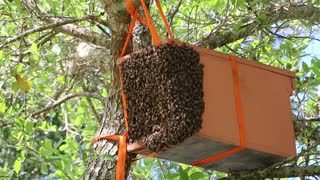Badger Burying A Whole Cow Caught On Film - First Time Ever Seen
Incredible moment a wild badger buries an entire COW carcass in a world first.This is the first time that this behavior has been recorded in American badgers. Badgers were known to bury small mammals but never something so big. The time lapse video shows the animals as it buried the cow over five days. Badgers bury their food to keep fresh for later meals - A badger has been filmed burying an entire cow carcass for the first time.
While badgers are known to bury other items, including food stashes, nobody knew that they would, or even could, bury an animal carcass four times their size.
The amazing footage was captured by researchers in the Grassy Mountains of Utah.
While studying scavenger behavior in Utah's Great Basin Desert, University of Utah biologists observed an American badger bury a cow carcass alone.
This is the first known instance of a badger burying an animal larger than itself.
The finding suggests that badgers may have no limit to the size of animal they can cache.
They may therefore play an important role in sequestering large carcasses, which could benefit cattle ranchers in the West.
'We know a lot about badgers morphologically and genetically, but behaviorally there's a lot of blank spaces that need to be filled,' says Ethan Frehner, lead author on the paper documenting the behavior.
'This is a substantial behavior that wasn't at all known about.'
The team didn't originally intend to study badgers.
In January 2016, co-author Evan Buechley set out seven calf carcasses in Utah's Grassy Mountains, west of Salt Lake City.
Each carcass was staked down and equipped with a camera trap to document what scavengers visited which carcasses.
Mr Buechley, who studies vultures and other avian scavengers, hoped to learn more about the ecology of scavengers in the Great Basin during the winter.
Mr Buechley went out to check on the carcasses after a week, and found that one was missing.
'When I first got there I was bummed because it's hard to get these carcasses, to haul them out and set them up,' he said. 'I thought "Oh, well we've lost one after a week."'
He searched around the area, thinking that perhaps a coyote or mountain lion had dragged the carcass away, but after finding nothing, returned to the site and realized the ground where the carcass had been was disturbed.
'Right on the spot I downloaded the photos,' he said. 'We didn't go out to study badgers specifically, but the badger declared itself to us.'
Little was previously known about badger behavior, Mr Frehner says.
'They're an enigmatic species. A substantial amount of their lifetime is spent either underground or a lot of nocturnal behavior, so it's hard to directly observe that.'
Camera traps, a relatively new tool for researchers, made it possible to observe more natural behaviors.
In the photos, Mr Buechley saw the badger dig around and beneath the carcass, which disappeared into the cavity created by the excavation.
'Watching badgers undertake this massive excavation around and underneath is impressive,' Mr Frehner says. 'It's a lot of excavation engineering they put into accomplishing this.'
Camera trap records show that the badger completely buried the roughly 50-pound (23kg) carcass over the course of five days.
He then spent around two weeks in his underground burrow before leaving and intermittently returning to the burrow for the next few weeks until early March.
According to the researchers, badgers cache food to isolate it from other scavengers and to keep it in an environment where it will last longer.
'Like putting it in the fridge,' Buechley says.
Senior author, Tara Christensen, assembled a time-lapse video of the burial, which shows the badger sitting contently atop the burrow.
Mr Buechley says: 'Not to anthropomorphize too much, but he looks like a really really happy badger, rolling in the dirt and living the high life.'
Another badger, at another site in the same study, also attempted to bury a calf carcass, suggesting that the behavior is likely widespread for badgers.
'A large dead ungulate can provide a ton of resources. So far on the carcasses we've put out, we've had turkey vultures, golden eagles, many ravens, bobcats, kit fox and coyote, so there's a lot of animals that could be using this resource, and the badger just monopolies it.'
The badger could also provide an ecological service to ranchers.
But if badgers can bury a calf, they may bury other carrion before any diseases incubating in the carcass can infect other cows.Keeping large predators away is a big deal for a lot of ranchers. You could argue that if the carcasses are being buried, they're not going to be attracting large predators.'
Music: The Takeover by Dhruva Aliman
Amazon - https://amzn.to/2B9tGa7
https://music.apple.com/us/artist/dhruva-aliman/363563637
https://dhruvaaliman.bandcamp.com/album/road-of-fortunes
http://www.dhruvaaliman.com/
Spotify - https://open.spotify.com/artist/5XiFCr9iBKE6Cupltgnlet
#animals
#nature
#strange
-
 1:05
1:05
My Adventures in Bee Keeping
3 years ago $0.01 earnedFirst Swarm Ever Caught, HUGE
75 -
 14:36
14:36
yashnar
2 years agoPUBG mobile first time ever played
12 -
 3:10:32
3:10:32
SNEAKO
13 hours agoIs Trump a Criminal?
104K71 -
 2:22:40
2:22:40
Jewels Jones Live ®
1 day agoTHE ART OF LAWFARE | A Political Rendezvous - Ep. 79
70.1K32 -
 25:30
25:30
Stephen Gardner
1 day ago🔴BREAKING: Trump MISTRIAL details | George Clooney's Netanyahu SECRET LEAKS!!
84.8K438 -
 1:18:43
1:18:43
Kim Iversen
1 day agoAmbassador Chas Freeman "Israel Has Never Put Forward A Peace Proposal"
97.9K212 -
 48:34
48:34
Breaking Points
2 days agoMAGA Lawyer DEBATES Liberal Analyst On Trump Legal Cases
67.8K72 -
 19:09
19:09
Scammer Payback
4 days agoConfronting Scammer Payback Imposters
121K40 -
 9:07
9:07
shaneyyricch
1 day agoAddressing my beef with Harry Sisson
111K113 -
 1:52:46
1:52:46
Game On!
1 day ago $2.75 earnedBoston Celtics Can't Win Game 2! | Sports Morning Espresso Shot
100K35